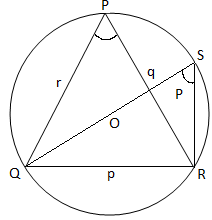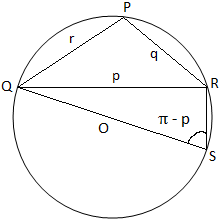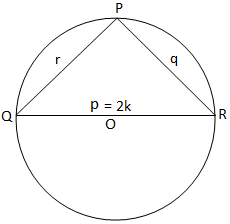Subscribe to our ▶️ YouTube channel 🔴 for the latest videos, updates, and tips.
Theorem on Properties of Triangle
Proof the theorems on properties of triangle \(\frac{p}{sin P}\) = \(\frac{q}{sin Q}\) = \(\frac{r}{sin R}\) = 2K
Proof:
Let O be the circum-centre and K the circum-radius of any triangle PQR.
Since in triangle PQR, three angles are acute in figure (i), then we observe that the triangle PQR is acute-angled in figure (ii), the triangle PQR is obtuse-angled (since its angle P is obtuse) and in figure (iii), the triangle PQR is right-angled (since the angle P is right angle). In figure (i) and figure (ii) we join QO and produce it to meet the circumference at S. Then join RS.
Clearly, QO = circum-radius = K
Therefore, QS = 2 ∙ QO = 2K and ∠QRS = 90° (being the semi-circular angle).
Now, from figure (i)we
get,
∠QSR = ∠QPR = P (being the angles on the same arc QR).
Therefore, from the triangle QRS we have,
QR/QS = sin ∠QSR
⇒ p/2K = sin P
⇒ p/sin P = 2K
Again, from figure (ii) we get,
∠QSR = π - P [Since, ∠QSR + ∠QPR = π]
Therefore, from the triangle QRS we get,
QR/QS = sin ∠QSR
⇒ p/2K = sin (π - P)
⇒ p/2K = sin P
⇒ a/sin P = 2K
Finally, for right-angled triangle, we get from figure (iii),
2K = p = p/sin 90° = p/sin P [Since, P = 90°]
Therefore, for any triangle PQR (acute-angled, or obtuse-angled or right-angled) we have,
Similarly, if we join PO and produce it to meet the circumference at T then joining RT and QE we can prove
q/sin Q = 2K and r/sin R = 2K …………………………….. (1)
Therefore, in any triangle PQR we have,
\(\frac{p}{sin P}\) = \(\frac{q}{sin Q}\) = \(\frac{r}{sin R}\) = 2K
Note: (i) The relation \(\frac{p}{sin P}\) = \(\frac{q}{sin Q}\) = \(\frac{r}{sin R}\) is known as Sine Rule.
(ii) Since, p : q : r = sin P : sin Q : sin R
Therefore, in any triangle the lengths of sides are proportional to the sines of opposite angles.
(iii) From (1) we get, p = 2K sin P, q = 2K sin Q and r = 2K sin R. These relations give the sides in terms of sines of angles.
Again, from (1) we get, sin P = p/2K, sin Q = q/2K and sin R = r/2K
These relations give the sines of the angles in terms of the sides of any triangle.
Solved problems using theorem on properties of triangle:
1. In the triangle PQR, if P = 60°, show that,
q + r = 2p cos \(\frac{Q - R}{2}\)
Solution:
We have,
We know that
\(\frac{p}{sin P}\) = \(\frac{q}{sin Q}\) = \(\frac{r}{sin R}\) = 2K.
⇒ p = 2K sin P, q = 2K sin Q and r = 2K sin R.
\(\frac{q + r}{2p}\) = \(\frac{2K sin Q + 2K sin R}{2 ∙ 2K sin P}\), [Since, p = 2K sin P, q = 2K sin Q and r = 2K sin R]
= \(\frac{sin Q + sin R}{2 sin P}\)
= \(\frac{2 sin \frac{Q + R}{2} cos \frac{Q - R}{2}}{2 sin 60°}\)
= \(\frac{sin 60° cos \frac{Q - R}{2}}{sin 60°}\),
[Since, P + Q + R = 180°, and P = 60° Therefore, Q + R = 180° - 60° = 120° ⇒ \(\frac{Q + R}{2}\) = 60°]
⇒ \(\frac{q + r}{2p}\) = cos \(\frac{Q - R}{2}\)
Therefore, q + r = 2p cos \(\frac{Q - R}{2}\) proved.
2. In any triangle PQR, prove that,
(q\(^{2}\) - r\(^{2}\)) cot P + (r\(^{2}\) - p\(^{2}\)) cot Q + (p\(^{2}\) - q\(^{2}\)) cot R = 0.
Solution:
\(\frac{p}{sin P}\) = \(\frac{q}{sin Q}\) = \(\frac{r}{sin R}\) = 2K.
⇒ p = 2K sin P, q = 2K sin Q and r = 2K sin R.
Now, (q\(^{2}\) - r\(^{2}\)) cot P = (4K\(^{2}\) sin\(^{2}\) Q - 4K\(^{2}\) sin\(^{2}\) R) cot P
= 2K\(^{2}\) (2 sin\(^{2}\) Q - 2 sin\(^{2}\) R)
= 2K\(^{2}\) (1 - cos 2Q - 1 + cos 2R) cot P
= 2K\(^{2}\) [2 sin (Q + R) sin (Q - R)] cot P
=4K\(^{2}\) sin (π - P) sin (Q - R) cot A, [Since, P + Q + R = π]
= 4K\(^{2}\) sin P sin (Q - R) \(\frac{cos P}{sin P}\)
= 4K\(^{2}\) sin (Q - R) cos {π - (Q - R)}
= - 2K\(^{2}\) ∙ 2sin (Q - R) cos (Q + R)
= - 2K\(^{2}\) (sin 2Q - sin 2R)
Similarly, (r\(^{2}\) - p\(^{2}\)) cot Q = -2K\(^{2}\) (sin 2R - sin 2P)
and (p\(^{2}\) - q\(^{2}\)) cot R = -2K\(^{2}\) (sin 2R - sin 2Q)
Now L.H.S. = (q\(^{2}\) - r\(^{2}\)) cot P + (r\(^{2}\) - p\(^{2}\)) cot Q + (p\(^{2}\) - q\(^{2}\)) cot R
= - 2K\(^{2}\) (sin 2Q - sin 2R) - 2K\(^{2}\) (sin 2R - sin 2P) - 2K\(^{2}\)(sin 2P - sin 2Q)
= - 2K\(^{2}\) × 0
= 0 = R.H.S. Proved.
- The Law of Sines or The Sine Rule
- Theorem on Properties of Triangle
- Projection Formulae
- Proof of Projection Formulae
- The Law of Cosines or The Cosine Rule
- Area of a Triangle
- Law of Tangents
- Properties of Triangle Formulae
- Problems on Properties of Triangle
11 and 12 Grade Math
From Theorem on Properties of Triangle to HOME PAGE
Didn't find what you were looking for? Or want to know more information about Math Only Math. Use this Google Search to find what you need.





New! Comments
Have your say about what you just read! Leave me a comment in the box below. Ask a Question or Answer a Question.